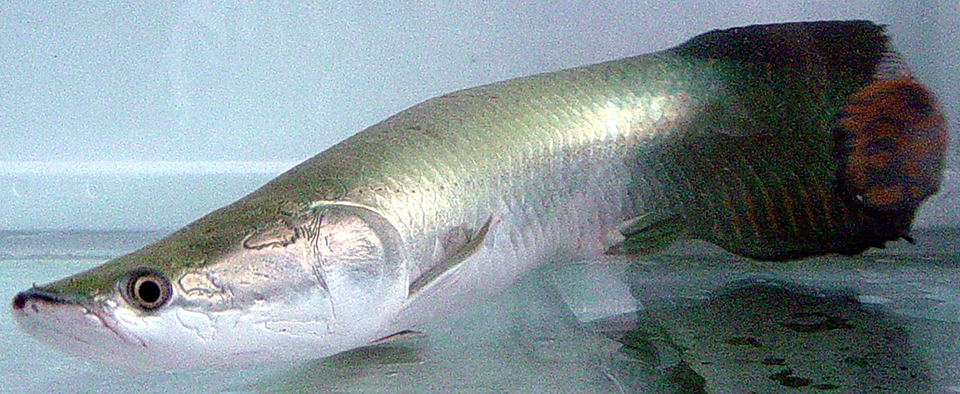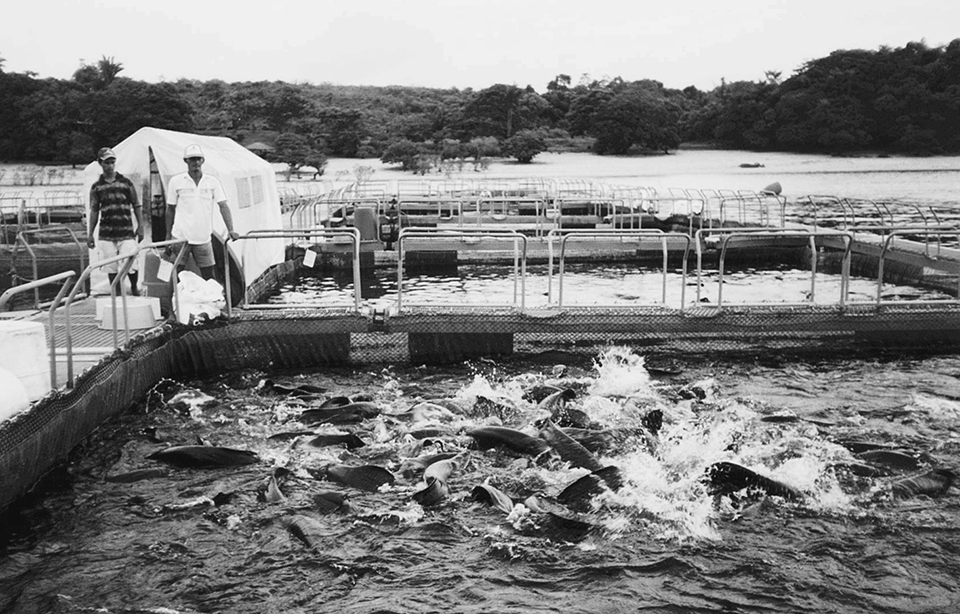Controlled breeding needed to shore up fingerling supplies

The pirarucu (Arapaima gigas) is an obligate air-breathing, carnivorous fish species indigenous to the Amazon that is among the largest freshwater fish in the world. Wildcaught pirarucu reach up to 200 kg in live weight and over 2.5 meters in length.
The low fat content, mild taste, and white boneless fillets of pirarucu flesh combines with the species’ fame as an ancient tropical fish to command high value in both domestic and international food and ornamental fish markets.
Development of culture techniques
Wild stocks of the species have been overexploited to a point where the trade of A. gigas is presently under the regulation of the Convention on International Trade in Endangered Species of Wild Fauna and Flora. As a response to market demand and to discourage the continuing harvest of natural pirarucu populations, research to develop intensive culture techniques have been carried out by Instituto Nacional de Pesquisas da Amazônia (INPA) and fish producers in the central Amazon of Brazil.
During the past five years, promising results have been reported, with emphasis on the production of fingerlings and feed-trained advanced juveniles. Grow-out trials in net cages and earthen ponds with fish fed floating pellets have also been successful.
Current practices
Commercial production evaluations and research experiments in Amazonas, Brazil, have shown that some of the rearing techniques used in the intensive culture of freshwater carnivorous fish such as the largemouth bass, peacock bass, and spotted catfish can also be successfully applied to pirarucu.
Fry transfer and nursery
Generally, pirarucu broodfish are stocked in 400- to 800-square-meter earthen ponds and allowed to breed naturally, which occurs mainly between midspring and midsummer. As soon as a tight school of fry is sighted, they are collected and transferred to fertilized nursery ponds. The 20-mm-long fry are stocked at 10 to 15 fish per cubic meter in the ponds.
During the nursery phase, live zooplankton is the major food source for pirarucu. Its production is stimulated by applying a combination of organic rice bran and inorganic urea fertilizers. After 20 days, 0.4- to 0.6-gram fingerlings are harvested and transferred to an indoor facility, where they are weaned and trained to feed on dry, formulated diets. Survival rates during nursery in small-scale commercial production have ranged 65 to 85 percent, depending on food availability and predator occurrence.
Feed training of juveniles
Juvenile pirarucu are confined in tanks of various shapes and sizes while they are trained to feed on artificial diets. Fiberglass vats with flowthrough water have been the most appropriate type of facility for training pirarucu, due to their efficient removal of wastes and maintenance of good water quality to prevent disease problems.
After stocking in vats, pirarucu juveniles are fed a starter diet for three or four days and weaned to dry ration using a gradual transition of diets prepared with increasing amounts of the final diet. Experiments carried out at INPA have shown that live artemia sp. or zooplankton are a more efficient starter diet than feeds with 0.5 percent monosodium glutamate, 5 percent fish silage, or 5 percent salt-dried shrimp used as attractants.
Successful transition from starter to final diet has been obtained offering a sequence of feeds containing 75, 50 and 25 percent of the starter diet for three days each (Table 1). Feed-training success after four days on the final diet has been as high as 95 percent. After the training period, juveniles are transferred to rearing ponds or cages.
Ono, Feeding protocol used to train pirarucu, Table 1
| Feeding Phase | Diet | Duration (days) | Feeding Frequency (times/day) |
|---|---|---|---|
| Starter | Zooplankton or Artemia sp. (SD) | 3 | 10-12 |
| Transition | 75% SD + 25% FD | 3 | 8-10 |
| Transition | 50% SD + 50% FD | 3 | 6-8 |
| Transition | 25% SD + 75% FD | 3 | 6 |
| Final | Dry feed (FD) | 4 | 6 |
Grow-out trials
Growout to market size of pirarucu fed floating pellets has been done in the Central Amazon using earthen ponds and floating cages in rivers and reservoirs. Field trials in ponds by commercial producers have resulted in growth from juveniles with a mean weight of 0.02 kg up to market size of 10 kg in a 14-month period under optimum temperature conditions. Yields in ponds with less than 5 percent daily water exchange have reached as high as 20,000 kilogram per hectare.
In floating cages installed in large rivers and reservoirs, pirarucu have been grown from 0.03 kg to 10 kg in about 12 months, with yields of 50 to 100 kilograms per cubic meter in 50- and 300-cubic-meter cages. To date, the best results have been obtained using feeds with 42 to 48 percent crude protein content.
Pirarucu have shown good tolerance to high stocking densities in cages and fast growth – even in water with low dissolved-oxygen concentrations typical in the Central Amazon’s water bodies. Acceptance of artificial diets in the early life stages has also contributed to higher survival rates and reduced the use of expensive live food. On the other hand, the unpredictable harvest of fry from natural spawning ponds limits the supply of fingerlings and is a major factor that restricts large-scale production of the species.

Conclusion
The pirarucu is a promising species for tropical aquaculture due to its market value and good performance under intensive culture. Currently, largescale production of pirarucu is limited by the lack of fingerlings, which will only be solved with the development of controlled breeding techniques.
(Editor’s Note: This article was originally published in the August 2003 print edition of the Global Aquaculture Advocate.)
Now that you've finished reading the article ...
… we hope you’ll consider supporting our mission to document the evolution of the global aquaculture industry and share our vast network of contributors’ expansive knowledge every week.
By becoming a Global Seafood Alliance member, you’re ensuring that all of the pre-competitive work we do through member benefits, resources and events can continue. Individual membership costs just $50 a year. GSA individual and corporate members receive complimentary access to a series of GOAL virtual events beginning in April. Join now.
Not a GSA member? Join us.
Authors
-
Eduardo A. Ono
Instituto Nacional de Pesquisas da Amazônia-INPA
Coordenação de Pesquisas em Aqüicultura
Av. André Araújo, 2936
Manaus, Amazonas, Brazil
69083-000[109,111,99,46,108,111,97,64,117,100,101,111,110,111]
-
Rodrigo Roubach
Instituto Nacional de Pesquisas da Amazônia-INPA
Coordenação de Pesquisas em Aqüicultura
Av. André Araújo, 2936
Manaus, Amazonas, Brazil
69083-000 -
Manoel Pereira-Filho
Instituto Nacional de Pesquisas da Amazônia-INPA
Coordenação de Pesquisas em Aqüicultura
Av. André Araújo, 2936
Manaus, Amazonas, Brazil
69083-000
Tagged With
Related Posts

Innovation & Investment
Pirarucu culture in the Brazilian Amazon
With their fast growth and ample light-flavored flesh, pirarucu present great potential. Industry growth is hampered by limited technology and management of domestication practices. Also, current commercial diets are typically not fully suited to the nutritional needs of pirarucu.

Responsibility
Changing the production chain of Amazonian pirarucu
Studies in Brazil over the last five years addressed the challenges facing commercial producers of the important, air-breathing, freshwater fish pirarucu in order to support and expand production.

Health & Welfare
Aquaculture of Amazon fish in Latin America
Many fish species that live in the Amazon basin have great potential for aquaculture. The main species currently cultured in the region is tambaqui, a fast-growing, omnivorous fish that tolerates poor water quality.

Innovation & Investment
Aquaculture planning, development in Brazilian federal waters
The aquaculture industry in Brazil is moving toward further expansion with the support of the federal government. A key strategy of the More Fishing and Aquaculture plan is the development of aquaculture in federal waters. The plan promotes sustainable development of fisheries and aquaculture by linking those involved and consolidating state policies addressing social inclusion, security and food sovereignty. Tilapia is the main farmed fish, although tambaqui and others have potential for large-scale production due to their wide acceptance by consumers.


